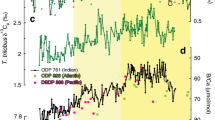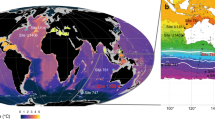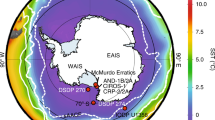Abstract
The middle Miocene climate transition (~14 million years ago) was characterized by a dramatic increase in the volume of the Antarctic ice sheet. The driving mechanism of this transition remains under discussion, with hypotheses including circulation changes, declining carbon dioxide in the atmosphere and orbital forcing. Southern Ocean records of planktic foraminiferal Mg/Ca have previously been interpreted to indicate a cooling of 6–7 °C and a decrease in salinity that preceded Antarctic cryosphere expansion by up to ~300,000 years. This interpretation has led to the hypothesis that changes in meridional heat and vapour transport along with an early thermal isolation of Antarctica from extrapolar climates played a fundamental role in triggering ice growth. Here we revisit the middle Miocene Southern Ocean temperature evolution using clumped isotope and lipid biomarker temperature proxies. Our records indicate that the Southern Ocean cooling and the associated salinity decrease occurred in phase with the expansion of the Antarctic ice sheet. We demonstrate that the timing and magnitude of the Southern Ocean temperature change seen in previous reconstructions can be explained if we consider pH as an additional, non-thermal, control on foraminiferal Mg/Ca ratios. Therefore, our new dataset challenges the view of a thermal isolation of Antarctica preceding ice sheet expansion, and suggests a strong coupling between Southern Ocean conditions and Antarctic ice volume in times of declining atmospheric carbon dioxide.
This is a preview of subscription content, access via your institution
Access options
Access Nature and 54 other Nature Portfolio journals
Get Nature+, our best-value online-access subscription
$29.99 / 30 days
cancel any time
Subscribe to this journal
Receive 12 print issues and online access
$259.00 per year
only $21.58 per issue
Buy this article
- Purchase on Springer Link
- Instant access to full article PDF
Prices may be subject to local taxes which are calculated during checkout




Similar content being viewed by others
Data availability
The clumped isotope and TEX86 temperature data that support the findings of this study are available in the Supplementary Information and at Pangaea (https://doi.org/10.1594/PANGAEA.919353, https://doi.org/10.1594/PANGAEA.919351). The full raw isotope data is published on the EarthChem Database (https://doi.org/10.26022/IEDA/111547).
References
Ji, S. C. et al. A symmetrical CO2 peak and asymmetrical climate change during the middle Miocene. Earth Planet. Sci. Lett. 499, 134–144 (2018).
Sosdian, S. M. et al. Constraining the evolution of Neogene ocean carbonate chemistry using the boron isotope pH proxy. Earth Planet. Sci. Lett. 498, 362–376 (2018).
Super, J. R. et al. North Atlantic temperature and pCO2 coupling in the early–middle Miocene. Geology 46, 519–522 (2018).
Flower, B. P. & Kennett, J. P. Middle Miocene ocean-climate transition—high-resolution oxygen and carbon isotopic records from Deep-Sea Drilling Project Site 588A, Southwest Pacific. Paleoceanography 8, 811–843 (1993).
Zachos, J. C., Pagani, M., Sloan, L., Thomas, E. & Billups, K. Trends, rhythms, and aberrations in global climate 65 Ma to present. Science 292, 686–693 (2001).
de Boer, B., van de Wal, R. S. W., Bintanja, R., Lourens, L. J. & Tuenter, E. Cenozoic global ice-volume and temperature simulations with 1-D ice-sheet models forced by benthic δ18O records. Ann. Glaciol. 51, 23–33 (2010).
Lear, C. H., Mawbey, E. M. & Rosenthal, Y. Cenozoic benthic foraminiferal Mg/Ca and Li/Ca records: toward unlocking temperatures and saturation states. Paleoceanography 25, PA4215 (2010).
Frigola, A., Prange, M. & Schulz, M. Boundary conditions for the middle Miocene climate transition (MMCT v1.0). Geosci. Model Dev. 11, 1607–1626 (2018).
Shevenell, A. E., Kennett, J. P. & Lea, D. W. Middle Miocene Southern Ocean cooling and Antarctic cryosphere expansion. Science 305, 1766–1770 (2004).
Kuhnert, H., Bickert, T. & Paulsen, H. Southern Ocean frontal system changes precede Antarctic ice sheet growth during the middle Miocene. Earth Planet. Sci. Lett. 284, 630–638 (2009).
Holbourn, A., Kuhnt, W., Schulz, M. & Erlenkeuser, H. Impacts of orbital forcing and atmospheric carbon dioxide on Miocene ice-sheet expansion. Nature 438, 483–487 (2005).
Gray, W. R. & Evans, D. Nonthermal influences on Mg/Ca in planktonic foraminifera: a review of culture studies and application to the Last Glacial Maximum. Paleoceanogr. Paleoclimatol. 34, 306–315 (2019).
Holland, K. et al. Constraining multiple controls on planktic foraminifera Mg/Ca. Geochim. Cosmochim. Acta 273, 116–136 (2020).
Exon, N. F. et al. in Proc. Ocean Drilling Program Initial Reports Vol. 189, Ch. 6 (ODP, 2001).
Ghosh, P. et al. 13C–18O bonds in carbonate minerals: a new kind of paleothermometer. Geochim. Cosmochim. Acta 70, 1439–1456 (2006).
Peral, M. et al. Updated calibration of the clumped isotope thermometer in planktonic and benthic foraminifera. Geochim. Cosmochim. Acta 239, 1–16 (2018).
Leutert, T. J. et al. Sensitivity of clumped isotope temperatures in fossil benthic and planktic foraminifera to diagenetic alteration. Geochim. Cosmochim. Acta 257, 354–372 (2019).
Meinicke, N. et al. A robust calibration of the clumped isotopes to temperature relationship for foraminifers. Geochim. Cosmochim. Acta 270, 160–183 (2020).
Schouten, S., Hopmans, E. C., Schefuss, E. & Damsté, J. S. S. Distributional variations in marine crenarchaeotal membrane lipids: a new tool for reconstructing ancient sea water temperatures? Earth Planet. Sci. Lett. 204, 265–274 (2002).
Schouten, S., Hopmans, E. C. & Damsté, J. S. S. The organic geochemistry of glycerol dialkyl glycerol tetraether lipids: a review. Org. Geochem. 54, 19–61 (2013).
Elling, F. J., Konneke, M., Mussmann, M., Greve, A. & Hinrichs, K. U. Influence of temperature, pH, and salinity on membrane lipid composition and TEX86 of marine planktonic Thaumarchaeal isolates. Geochim. Cosmochim. Acta 171, 238–255 (2015).
Heath, R. A. et al. A review of the physical oceanography of the seas around New Zealand—1982. N. Z. J. Mar. Freshwater Res. 19, 79–124 (1985).
Torsvik, T. H. et al. Phanerozoic polar wander, palaeogeography and dynamics. Earth Sci. Rev. 114, 325–368 (2012).
van Hinsbergen, D. J. J. et al. A paleolatitude calculator for paleoclimate studies. PLoS ONE 10, e0126946 (2015).
King, A. L. & Howard, W. R. Seasonality of foraminiferal flux in sediment traps at Chatham Rise, SW Pacific: implications for paleotemperature estimates. Deep-Sea Res. I 48, 1687–1708 (2001).
Pahnke, K., Zahn, R., Elderfield, H. & Schulz, M. 340,000-year centennial-scale marine record of Southern Hemisphere climatic oscillation. Science 301, 948–952 (2003).
Vázquez Riveiros, N. et al. Mg/Ca thermometry in planktic foraminifera: improving paleotemperature estimations for G. bulloides and N. pachyderma left. Geochem. Geophys. Geosyst. 17, 1249–1264 (2016).
Sangiorgi, F. et al. Southern Ocean warming and Wilkes Land ice sheet retreat during the mid-Miocene. Nat. Commun. 9, 317 (2018).
Knorr, G. & Lohmann, G. Climate warming during Antarctic ice sheet expansion at the middle Miocene transition. Nat. Geosci. 7, 376–381 (2014).
Ho, S. L. & Laepple, T. Flat meridional temperature gradient in the early Eocene in the subsurface rather than surface ocean. Nat. Geosci. 9, 606–610 (2016).
Evans, D. & Müller, W. Deep time foraminifera Mg/Ca paleothermometry: nonlinear correction for secular change in seawater Mg/Ca. Paleoceanography 27, PA4205 (2012).
Lear, C. H. et al. Neogene ice volume and ocean temperatures: insights from infaunal foraminiferal Mg/Ca paleothermometry. Paleoceanography 30, 1437–1454 (2015).
Shevenell, A. E., Kennett, J. P. & Lea, D. W. Southern Ocean Middle Miocene ODP1171 Foraminifer Stable Isotope and Mg/Ca Data IGBP PAGES/World Data Center for Paleoclimatology Data Contribution Series no. 2006-061 (NOAA/NCDC, 2006).
Gray, W. R. et al. The effects of temperature, salinity, and the carbonate system on Mg/Ca in Globigerinoides ruber (white): a global sediment trap calibration. Earth Planet. Sci. Lett. 482, 607–620 (2018).
Toggweiler, J. R., Russell, J. L. & Carson, S. R. Midlatitude westerlies, atmospheric CO2, and climate change during the ice ages. Paleoceanography 21, PA2005 (2006).
Anderson, R. F. et al. Wind-driven upwelling in the Southern Ocean and the deglacial rise in atmospheric CO2. Science 323, 1443–1448 (2009).
Sigman, D. M., Hain, M. P. & Haug, G. H. The polar ocean and glacial cycles in atmospheric CO2 concentration. Nature 466, 47–55 (2010).
Studer, A. S. et al. Antarctic Zone nutrient conditions during the last two glacial cycles. Paleoceanography 30, 845–862 (2015).
Müller, R. D. et al. GPlates: building a virtual Earth through deep time. Geochem. Geophys. Geosyst. 19, 2243–2261 (2018).
Matthews, K. J. et al. Global plate boundary evolution and kinematics since the late Paleozoic. Glob. Planet. Change 146, 226–250 (2016).
Bernasconi, S. M. et al. Reducing uncertainties in carbonate clumped isotope analysis through consistent carbonate-based standardization. Geochem. Geophys. Geosyst. 19, 2895–2914 (2018).
Kele, S. et al. Temperature dependence of oxygen- and clumped isotope fractionation in carbonates: a study of travertines and tufas in the 6–95 °C temperature range. Geochim. Cosmochim. Acta 168, 172–192 (2015).
Kim, J. H. et al. New indices and calibrations derived from the distribution of crenarchaeal isoprenoid tetraether lipids: implications for past sea surface temperature reconstructions. Geochim. Cosmochim. Acta 74, 4639–4654 (2010).
Greenop, R. et al. A record of Neogene seawater δ11B reconstructed from paired δ11B analyses on benthic and planktic foraminifera. Clim. Past 13, 149–170 (2017).
Shevenell, A. E. & Kennett, J. P. in The Cenozoic Southern Ocean: Tectonics, Sedimentation, and Climate Change Between Australia and Antarctica Vol. 151 (eds Exon, N. et al.) 235–252 (AGU, 2004).
Shevenell, A. E., Kennett, J. P. & Lea, D. W. Middle Miocene ice sheet dynamics, deep-sea temperatures, and carbon cycling: a Southern Ocean perspective. Geochem. Geophys. Geosyst. 9, Q02006 (2008).
Schmid, T. W., Radke, J. & Bernasconi, S. M. Clumped-Isotope Measurements on Small Carbonate Samples with a Kiel IV Carbonate Device and a MAT 253 Mass Spectrometer Application Note 30233 (ThermoFisher, 2012).
Hu, B. et al. A modified procedure for gas-source isotope ratio mass spectrometry: the long-integration dual-inlet (LIDI) methodology and implications for clumped isotope measurements. Rapid Commun. Mass Spectrom. 28, 1413–1425 (2014).
Meckler, A. N., Ziegler, M., Millan, M. I., Breitenbach, S. F. M. & Bernasconi, S. M. Long-term performance of the Kiel carbonate device with a new correction scheme for clumped isotope measurements. Rapid Commun. Mass Spectrom. 28, 1705–1715 (2014).
Grauel, A. L. et al. Calibration and application of the ‘clumped isotope’ thermometer to foraminifera for high resolution climate reconstructions. Geochim. Cosmochim. Acta 108, 125–140 (2013).
Rodríguez-Sanz, L. et al. Penultimate deglacial warming across the Mediterranean Sea revealed by clumped isotopes in foraminifera. Sci. Rep. 7, 16572 (2017).
Schmid, T. W. & Bernasconi, S. M. An automated method for ‘clumped-isotope’ measurements on small carbonate samples. Rapid Commun. Mass Spectrom. 24, 1955–1963 (2010).
Piasecki, A. et al. Application of clumped isotope thermometry to benthic foraminifera. Geochem. Geophys. Geosyst. 20, 2082–2090 (2019).
Huntington, K. W. et al. Methods and limitations of ‘clumped’ CO2 isotope (Δ47) analysis by gas-source isotope ratio mass spectrometry. J. Mass Spectrom. 44, 1318–1329 (2009).
Auderset, A., Schmitt, M. & Martínez-García, A. Simultaneous extraction and chromatographic separation of n-alkanes and alkenones from glycerol dialkyl glycerol tetraethers via selective accelerated solvent extraction. Org. Geochem. 143, 103979 (2020).
Hopmans, E. C., Schouten, S. & Damsté, J. S. S. The effect of improved chromatography on GDGT-based palaeoproxies. Org. Geochem. 93, 1–6 (2016).
Huguet, C. et al. An improved method to determine the absolute abundance of glycerol dibiphytanyl glycerol tetraether lipids. Org. Geochem. 37, 1036–1041 (2006).
Evans, D., Brierley, C., Raymo, M. E., Erez, J. & Müller, W. Planktic foraminifera shell chemistry response to seawater chemistry: Pliocene–Pleistocene seawater Mg/Ca, temperature and sea level change. Earth Planet. Sci. Lett. 438, 139–148 (2016).
Cramwinckel, M. J. et al. Synchronous tropical and polar temperature evolution in the Eocene. Nature 559, 382–386 (2018).
Shackleton, N. J. Attainment of isotopic equilibrium between ocean water and the benthonic foraminifera genus Uvigerina: isotopic changes in the ocean during the last glacial. Colloq. Int. C.N.R.S. 219, 203–209 (1974).
Bemis, B. E., Spero, H. J., Bijma, J. & Lea, D. W. Reevaluation of the oxygen isotopic composition of planktonic foraminifera: experimental results and revised paleotemperature equations. Paleoceanography 13, 150–160 (1998).
Schmidt, G. A., Bigg, G. R. & Rohling, E. J. Global Seawater Oxygen-18 Database Version 1.22 (GISS, 1999); https://data.giss.nasa.gov/o18data/
Acknowledgements
We thank A. Shevenell, D. Evans, G. Foster and A. Fernandez Bremer for insightful discussions, and E. Alagoz, I. Heggstad and M. Schmitt for laboratory assistance. Furthermore, we thank all authors who shared their published data. This research used data and samples provided by the International Ocean Discovery Program (IODP) and its predecessor, the Ocean Drilling Program (ODP). The work was funded by the European Research Council (ERC) under the European Union’s Horizon 2020 research and innovation programme (grant agreement no. 638467), the Trond Mohn Foundation and the Max Planck Society.
Author information
Authors and Affiliations
Contributions
T.J.L. and A.N.M. initiated and designed the study. T.J.L. generated and analysed clumped isotope data under the oversight of A.N.M. A.A. and A.M.-G. contributed TEX86 data and their interpretation. GDGT measurements were performed by A.A. under the supervision of A.M.-G. All the authors contributed to the palaeoceanographic interpretation. T.J.L. wrote the paper with substantial contributions from A.N.M., A.A., A.M.-G. and S.M.
Corresponding author
Ethics declarations
Competing interests
The authors declare no competing interests.
Additional information
Peer review information Primary Handling Editor: James Super.
Publisher’s note Springer Nature remains neutral with regard to jurisdictional claims in published maps and institutional affiliations.
Supplementary information
Supplementary Information
This file contains Supplementary Methods 1 and 2, Discussions 1–4, Figs. 1–14 and Tables 1–3. In addition to providing additional information on site locality and hydrography, we present details on clumped isotope and lipid biomarker analyses as well as age models. Furthermore, we discuss potential non-thermal and diagenetic effects on the applied temperature proxies.
Supplementary Data
This file contains Supplementary Tables 4–9. Supplementary Table 4 contains the calculated standard reproducibilities for our stable isotope measurements. Supplementary Tables 5 and 6 show all the stable isotope standard and sample data, respectively. Supplementary Table 7 contains the calculated clumped isotope temperatures. Supplementary Table 8 contains the fractional abundances of GDGTs, calculated temperatures and indices, and Supplementary Table 9 lists the revised ages for boron isotope-based estimates of pH and CO2.
Rights and permissions
About this article
Cite this article
Leutert, T.J., Auderset, A., Martínez-García, A. et al. Coupled Southern Ocean cooling and Antarctic ice sheet expansion during the middle Miocene. Nat. Geosci. 13, 634–639 (2020). https://doi.org/10.1038/s41561-020-0623-0
Received:
Accepted:
Published:
Issue Date:
DOI: https://doi.org/10.1038/s41561-020-0623-0
This article is cited by
-
Late Miocene onset of the modern Antarctic Circumpolar Current
Nature Geoscience (2024)
-
A well-oxygenated eastern tropical Pacific during the warm Miocene
Nature (2023)
-
Neogene South Asian monsoon rainfall and wind histories diverged due to topographic effects
Nature Geoscience (2022)
-
Enhanced ocean oxygenation during Cenozoic warm periods
Nature (2022)
-
Warm deep-sea temperatures across Eocene Thermal Maximum 2 from clumped isotope thermometry
Communications Earth & Environment (2022)



